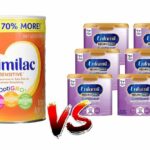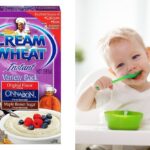Many parents turn to goat’s milk or another alternative milk as a result of their baby being unable to tolerate cow’s milk.
So now you find yourself researching every possible alternative to the traditional cow’s milk-based formula and I bet you never realized that there were so many out there.
From plant-based alternatives such as soy, almond, and even pea to another animal-derived option such as goat’s milk.
It isn’t recommended that baby’s under 1 year old are given either pasteurized goat or cow’s milk as they are unable to completely or easily digest it, unlike formula.
Also, they contain high levels of protein and lactose which can stress a newborn’s immature system and cause severe illness.
Goat’s milk and goat’s milk-based formulas may be a great alternative for babies and toddlers suffering from cow milk sensitivities or if you have concerns about cow milk in general.
But it may not be for everyone. So to help you make the best decision for your little we have taken a look at the pros and cons of goat’s milk vs cow’s milk.
The Main Differences Between Goat Milk and Cow Milk
There are some differences between goat’s milk and cow’s milk formula that may help you decide which is best for your little one.
- Goat milk has 20% smaller fat globules compared to cow’s milk making it easier to digest and is a good alternative to those unable to tolerate cow’s milk.
- Goat milk contains less lactose compared to cow’s milk. Lactose is the sugar that you find in milk
- Goat’s milk contains nutrients A2 protein and oligosaccharides, making it very similar to human breastmilk. Oligosaccharides act as prebiotics and stimulate the growth and division of the beneficial probiotic bacteria in the gut.
- Goat’s milk also contains 30-35 % fatty acids while cows milk only contains 15-210%. These fatty acids are a quick source of energy and are not stored as body fat.
- The taste will be a big difference that your baby may notice. Goat’s milk has a strong and distinctive flavor – it tastes like a goat smells!
Main Benefits of Goat Milk Infant Formula
View in gallery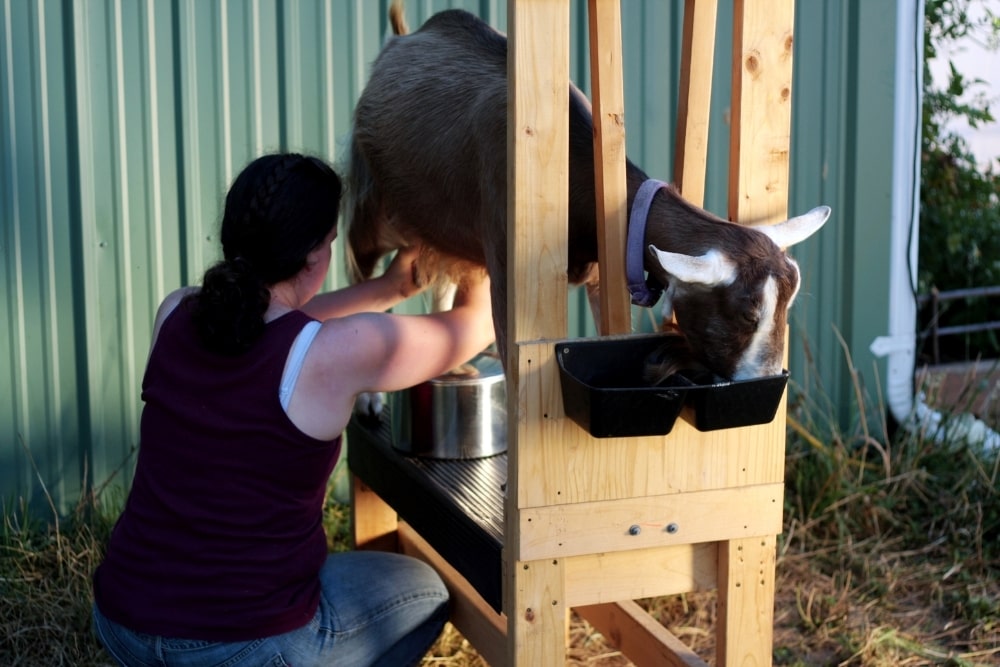
The pH of goat milk is closer to the pH of breastmilk
oat milk is alkaline the same as breastmilk while cow’s milk is acidic. Some experts have stated that due to goat’s milk pH levels it is often a better choice for infants as it can also decrease the chances of gastrointestinal infections.
A higher level of bio-availability
Goat milk is very similar to breastmilk, making it easier to digest and nutrients are absorbed quicker by the baby’s body.
Better absorption of iron
Over 50% of iron that is found in goat’s milk is more easily absorbed compared to only 13% of cow’s milk. This means that a baby gets more iron per milliliter of goat’s milk than from cow’s milk.
Easily digestible
Compared to cow’s milk, the fat in goat’s milk is composed of short-chain fatty acid that breaks down easily. This means that goat’s milk can be digested easier and quicker.
Supports baby’s immune system
Children’s immunity is not fully developed until five years old. This means that newborns and toddlers are at a much higher risk of developing infections. Goat’s milk boosts immunity as it contains a nutrient called selenium.
Lactose Intolerance
While goat’s milk is not lactose-free, it does contain less lactose than cow’s milk. Goat’s milk doesn’t cause indigestion or bloating and so may the best option to ease digestion issues.
Disadvantages of Goat Milk Infant Formula
Allergies
Many parents turn to goat’s milk as their children have sensitivities to cow’s milk but goat’s milk is an animal product and shares similar allergens with cow’s milk.
So it is actually very likely that if your child has a true cow’s milk allergy they will also be allergic to goat’s milk. Research has shown that goat’s milk can cause reactions in more than 90% of children who suffer from an allergy to cow’s milk.
Taste
If you have ever tried goat’s cheese you will know that it has a very earthy taste and you can expect goat’s milk to have the same taste. Some little ones may dislike the taste especially if they have been used to the taste of cow’s milk products.
Availability
This is going to be one of the biggest challenges that you will face. You are less likely to find goat’s milk on the shelves of your favorite grocery store.
You may have to scout out your local health food shops, special order it, or try some online shopping o source it.
Cost
As it is not so readily available you may also find that it will be slightly more expensive than the cow’s milk.
Common Reasons For Considering Goat’s Milk
Many parents get to the point of deciding to feed an alternative milk form for many reasons from allergies to feeling strongly about how the animals are raised. Here are some of the main reasons for considering goat’s milk.
[amalinkspro type=”showcase” asin=”B00MJ4ZC62″ apilink=”https://www.amazon.com/dp/B00MJ4ZC62?tag=mominformedcom-20&linkCode=osi&th=1&psc=1″ new-window=”true” addtocart=”false” nofollow=”true” sc-id=”4″ imgs=”LargeImage” link-imgs=”false” specs=”Naturally easy to digest, premium non-GMO goat milk formula, ideal for weaning and supplementing.~~~May be a solution for children with cow milk sensitivity*. Tummy troubles, congestion, and eczema may be associated with cow milk sensitivity. *not suitable for children with cow milk protein allergy~~~Kabrita Goat Milk Formula has a mild, sweet and fresh taste and smell. A safe, effective and nutritious alternative to homemade goat milk formula recipes.” btn-color=”#ff9900″ btn-text=”Buy on Amazon” alignment=”aligncenter” hide-prime=”0″ hide-image=”0″ hide-price=”0″ hide-button=”0″ width=”750″]Kabrita Goat Milk Toddler Formula, 14 oz[/amalinkspro]
One of the main reasons for considering goat’s milk is usually an allergy or intolerance to cow’s milk. An allergy to cow’s milk affects up to 3% of infants in the developed world.
Symptoms can range from diarrhea and coughing to far more serious symptoms such as shortness of breath and anaphylaxis.
You must take note that a cow’s milk allergy is not the same as cow’s milk protein intolerance. Protein intolerance affects around 55 of infants in the first 3 months of life.
But unlike an allergy, an intolerance doesn’t actually involve the immune system in any way. Some signs of cow’s milk intolerance are bloating, gas, and diarrhea.
It is also interesting that many people who have a cow’s milk allergy do not suffer the same allergy to goat’s milk. Now, this may be because goat’s milk is actually higher in protein and is easier to digest.
If you do intend to change your baby to a goat’s milk formula or pure goat’s milk you should always consult a pediatrician.
Main Benefits of Cow Milk Infant Formula
View in gallery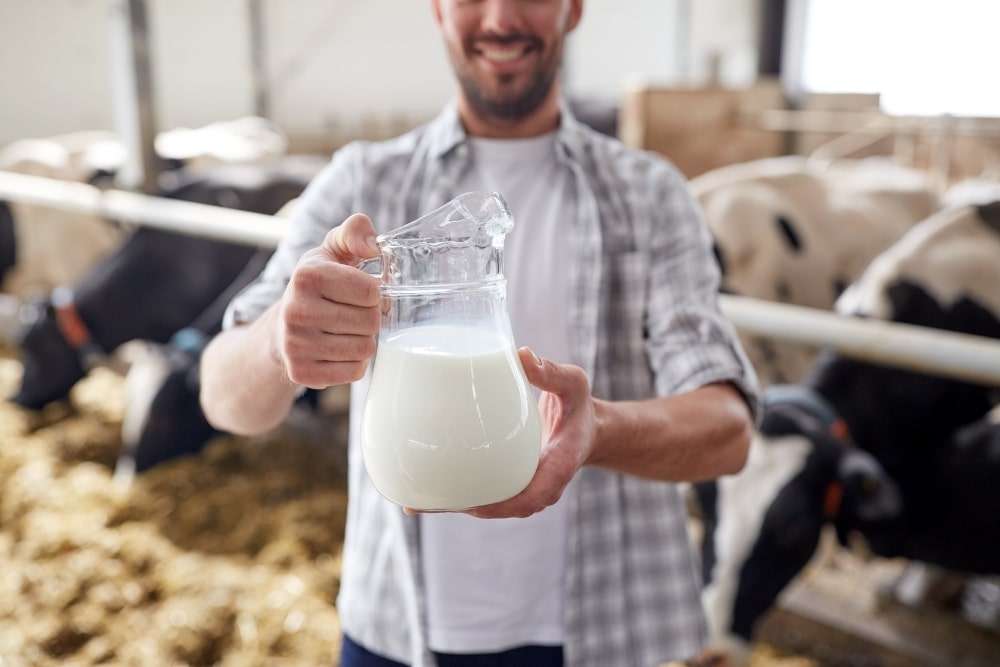
- It is a complete food that will meet all your baby’s nutritional needs. It contains high-quality proteins and the right amount of fat and carbs making it well-balanced.
- Growth and development – Cow’s milk help to support your little one’s growth and development.
- Diabetes – There is evidence to suggest that cows milk may help to prevent diabetes as it balances blood sugar levels.
- Choline source – Choline works as an antioxidant and helps to improve children’s intelligence, memory, and mood.
- Vitamin B – It is full of this vitamin that helps improve brain function, helps to regulate sleep-wake cycles, and supports the development of your baby’s nervous system.
- Calcium and Vitamin D – Cow’s milk contains calcium for the development of healthy and strong bones. More importantly, it contains vitamin D that boosts calcium absorption, and leads to strong teeth, muscles, and bones.
Disadvantages of Cow Milk Infant Formula
- Some cow’s milk may contain growth hormones that can be harmful to humans.
- Babies have a higher chance of being lactose-intolerant as cow’s milk contains a higher amount of lactose than goat’s milk. Children who are suffering from lactose intolerance may have symptoms such as breathing issues, rashes, constipation, diarrhea, or itchy nose.
- The fat in cow’s milk is made up of long-chain fatty acids making it more difficult to digest, especially for little ones.
[amalinkspro type=”showcase” asin=”B07YMD4M82″ apilink=”https://www.amazon.com/dp/B07YMD4M82?tag=mominformedcom-20&linkCode=osi&th=1&psc=1″ new-window=”true” addtocart=”false” nofollow=”true” sc-id=”4″ imgs=”LargeImage” link-imgs=”false” specs=”WITH PROBIOTICS: Pure Bliss by Similac Toddler Drink is thoughtfully crafted nutrition with probiotics for digestive health~~~NO COMPROMISE: With NO artificial growth hormones,* antibiotics, or palm olein oil, and it’s non-GMO~~~FOR BRAIN DEVELOPMENT: Pure Bliss has DHA, a key nutrient to support brain development” btn-color=”#ff9900″ btn-text=”Buy on Amazon” alignment=”aligncenter” hide-prime=”0″ hide-image=”0″ hide-price=”0″ hide-button=”0″ width=”750″]Pure Bliss by Similac Toddler Drink with Probiotics, Starts with Fresh Milk from Grass-Fed Cows[/amalinkspro]
Nutritional Value Comparison Goat Milk vs Cow Milk
Here is the nutritional value of goat’s milk, cow’s milk, and breastmilk side by side for you to compare. As you can see goat’s milk has more fat in 100g than cow’s milk but it is still less than breastmilk.
| Nutrient | Goat Milk | Cow Milk | Breastmilk |
| Lactose | 4.08 | 4.78 | 6.92 |
| Fat | 3.8 | 3.67 | 4 |
| Protein | 2.9 | 3.23 | 1.10 |
| Casein | 2.47 | 2.63 | 0.4 |
| Vitamin C (mg) | 2 | 2 | 3.6 |
| Vitamin B (ug) | 68 | 45 | 17 |
| Vitamin D (i.u) | 0.7 | 0.7 | 0.27 |
| Potassium (mg) | 204 | 150 | 51 |
| Sodium (mg) | 50 | 44 | 17 |
Homemade Formula
View in gallery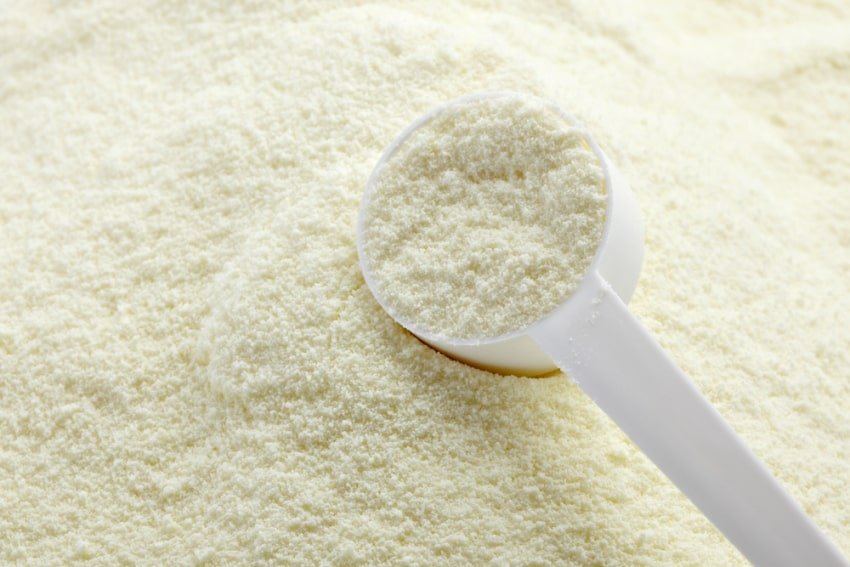
This is not as complicated as you may first think. There is nothing wrong with commercially manufactured baby formula, all my children have consumed it at some point in their first year of life, and if you choose to use a commercial formula that is just fine.
The vast majority of parents do. But if you are thinking that you would like to take another path due to the additives or preservatives that are found in the commercial formula here are a few recipes to get you started.
Goat Milk Formula Recipe
This recipe is quick and easy and should take you around 10 minutes to prepare. It will provide your baby with 25 calories per serving and the ingredients below are enough to make 36 ounces of formula.
Ingredients
- 2 cups of goat milk preferably organic
- 1/4 cup of liquid whey
- 1/4 teaspoon of Bifidobacterium Infantis powder
- 1 teaspoon of organic sunflower oil
- 2 teaspoons of organic coconut oil
- 1 teaspoon of extra virgin organic olive oil
- 4 tablespoons of goat lactose
- 1 and 7/8 cup of filtered water
- 2 tablespoons of pasteurized cream
- 1/4 teaspoon of unflavored butter oil
- 2 teaspoons of nutritional yeast
- 1/2 teaspoon of unflavored cod oil
- 2 teaspoons of gelatin
- 2 teaspoons of raw organic chicken liver finely grated
Method
- First, measure out the amount of water required.
- Pour half of the water into a pan and heat on medium on the stove.
- Add the lactose and the gelatin. Stir the mixture until both are completely dissolved.
- Remove the pan from the stove. Pour the remainder of the water into the pan.
- Add the butter oil and the coconut oil and stir until they melt.
- Use a blender, add all the remaining ingredients. Make sure to avoid powdered whey and use liquid one instead. Otherwise, your milk formula will coagulate and become more like cheese.
- Now you can pour the water mixture into the blender and process the entire thing for a couple of seconds.
- The milk formula is ready to be transferred to baby bottles. Then refrigerate until needed.
Cow Milk Formula Recipe
This recipe will take around 15 minutes to prepare and will make around 36 ounces of formula.
Ingredients
- 2 cups of cow’s milk
- 2 teaspoons of gelatin
- 2 teaspoons of organic coconut milk
- 1 and 7/8 cups of filtered water
- 1 teaspoon of extra virgin olive oil
- 1 teaspoon of organic sunflower oil
- 2 teaspoons of nutritional yeast
- 1/2 teaspoon of fermented cod liver oil
- 1/4 teaspoon of acerola powder
- 2-4 tablespoons of cream
- 1/4 cup of raw whey
- 1/4 teaspoon of Bifidobacterium Infantis powder
- 4 tablespoons of lactose.
Method
- Mix the following ingredients in a bowl ensuring that the measuring spoon stays dry: the Acerola powder, yeast flakes, and the Bifidobacterium Infantis powder.
- Use a small pan to heat the water on the stove at low-medium heat.
- Add the lactose and gelatin to the pan filled with water and leave it on the stove until both these ingredients are totally dissolved. Occasional stirring if necessary.
- Remove the pan from the stove, add the coconut oil and stir it well until it melts.
- Let the mixture cool down a bit and then pour it into a glass blender;
- Add all the other oils: sunflower, olive, and cod liver oil;
- Add the whey and pour the milk into the blender;
- Mix all the remaining dry ingredients together and add them to the blender. Blend for about 5 to 10 seconds;
- Then add the cream. Mix well to prevent bubbles, place them into bottles, and store until needed.
Alternatives to Goat and Cow Milk
If neither goat nor cow milk suits your baby’s needs then do not despair there are other alternatives available. Here are some of the alternative options available to you:
View in gallery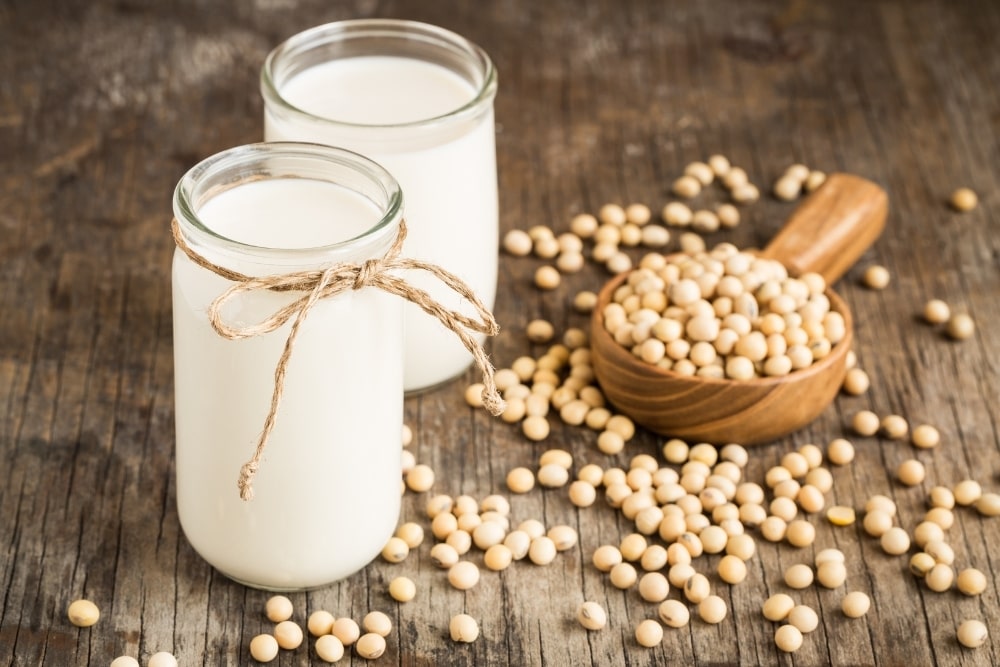
Soya milk
It’s packed with protein and fiber. It has some great benefits as it contains cancer-fighting isoflavones, minimal saturated fat, and the absence of galactose which means that it can replace breast milk for children that are galactosaemic.
Almond milk
It’s a good source of magnesium, which helps to break down food. It can help improve the health of bones.
Rice milk
This is the most hypoallergenic of all the milk substitutes and is extremely nutritious. It is also the least fattening of all the milk alternatives with only one gram of unsaturated fat per cup.
Sheep milk
Their milk contains up to twice as many minerals as cow’s milk, it has small fat globules the same as goat’s milk so is easy to digest. The downside of it is that it is twice as fattening as whole cow’s milk and has many more calories.
Goat Milk vs Cow Milk – The Winner Is…
To be honest as a parent it is completely your choice as to whether you decide to give your baby goat or cow milk-based formula.
Your reasons may be allergy and health-related or just down to concerns with regard to growth hormones in cow milk. Whatever your reasons both provide great nutrition and are healthy as long as guidelines are followed.
It may also be down to the preference of your little one as many babies dislike the taste of goat’s milk. Many children prefer cow’s milk as it is sweeter and is also a taste that they will be more accustomed to.
If you do decide to make the switch then you will need to be prepared that it may take a little time for your little one to get used to the taste of goat’s milk and goat’s milk products. Be patient with them.
FAQs
Why is goat milk not recommended for infants?
Goat’s milk is not recommended for infants because it is lacking in some essential vitamins and minerals. Goat’s milk does not have enough iron, folate, vitamins C and D, thiamin, niacin, vitamin B6, and pantothenic acid.
According to the US Department of Agriculture, babies who do not get enough iron or vitamin B6 develop anemia.
View in gallery
Is goat’s milk closest to breastmilk?
Goat’s milk is often considered as being one of the closest to breastmilk. But although it is rich in fat it should be used with caution in infant feeding as it does contain enough folic acid and vitamin B12 which are both essential for growth and development.
Can a baby survive on goat milk?
A baby under 1 year of age can not survive on fresh goat’s milk as it is very high in protein. But there is no reason why your infant could not survive and thrive on a goat milk-based formula.
Is goats milk suitable for babies with eczema?
If you decide to research this point you will find some claims that it can help to reduce the severity of eczema and reflux in infants. But solid research to back these claims is definitely lacking.
Where can I buy goats milk for babies?
Fresh goat’s milk can be purchased in health food stores and almost every supermarket will stock it.
If you are trying to purchase a goat milk-based infant formula, this may be more difficult to find in your local supermarkets. It is available to purchase online and from some health food and pharmacies.
The Final Thought
Whether you choose to breastfeed, formula feed, use soy-based formula or cow milk-based formula the important thing is that your baby is fed and that your feeding choice meets all their nutritional needs.
People have very strong opinions on how babies should be fed but formula or breastfeeding it really doesn’t matter as long as you are doing the best for your baby. After all, nobody knows your little one’s issues as you do!


